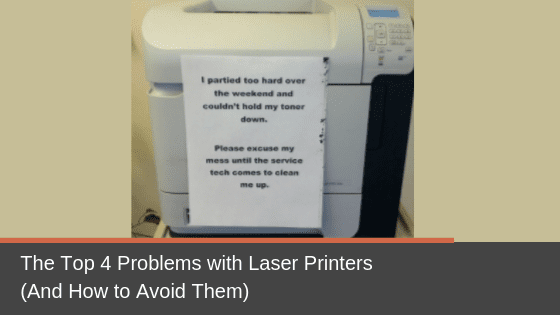So, you’re leaning towards buying a new laser printer for your office but curious about what the downside might be? There are certainly pros and cons to both inkjet and laser printers. But the ideal choice comes down to the needs of your office and the size of your budget.
In another article, we looked at some common problems with inkjet printers. Here, we’ll discuss a few of the general complaints people have about laser printers and some potential technical issues to consider.
General Complaints About Laser Printers.
Problem #1: They’re Too Expensive.
Laser printers tend to be more expensive than inkjet printers because the technology is more complex, and the devices are more durable.
Solution: Choose a Low-Cost Model That Fits Your Budget.
While it’s true that, in general, laser printers can cost more, their prices have come down a lot in recent years. You can now find a budget multifunction laser printer for a price that’s comparable to an inkjet model, as long as you don’t need colour printing. Modern laser printers are also more versatile than they used to be, so they’re a better fit for home or small offices than they used to be.
Problem #2: Consumables Cost Too Much.
Laser printers require two things to work: a toner cartridge and a drum unit that transfers the toner powder onto the paper. So, both will eventually have to be replaced, and while these consumables can last a long time, they don’t come cheap.
Solution: Find a Model with Fewer Consumables.
It’s easier than ever to find printers that are eco-friendly and cost-effective. For instance, Kyocera’s ECOSYS line of printers is designed to create less waste and offer a low cost per print. The company was the first manufacturer to develop a cartridge-free system for its laser printers.
You can also reduce costs by getting a printer that can take XL or super-high-yield cartridges, which can provide a better overall cost per print and lengthen the lifespan of the toner, so it doesn’t have to be replenished as often.
It’s essential to choose your toner wisely. Toner cartridges come with different price tags and page yields, which tell you how many pages you can expect to print with one cartridge. You can figure out a printer’s cost per page by dividing its page yield by the price of the toner cartridge.
One way to save money on toner is to buy new compatible cartridges from third-party manufacturers instead of the branded cartridges made by Original Equipment Manufacturers (OEM) as OEM cartridges are more expensive and can be challenging to recycle.
Common Technical Issues with Laser Printers
Problem #3: Poor Print Quality.
While laser printers aren’t designed to handle high-resolution photos, they should be able to produce simple graphs and images that are clear and crisp. If images are faded and text appears jagged, you’re not getting good value from your investment.
Solution: Buy a Device That Can Do It All.
It’s been a common belief that laser printers are no match for inkjet printers when it comes to printing coloured images. But a new generation of laser printers is challenging that perception. Models like the HP M203dw are more than capable of producing good quality colour images while still providing the speed, reliability and durability that laser printers have always been known for.
Still, there might be times when your print outs look faded, and there are a few reasons for that. The problem could be low toner or issues with the printer settings. Checking or replacing the toner often fixes the problem, and if it doesn’t, it’s always good to run a test to see if the printer’s settings need to be changed.
Problem #4: Paper Jams.
Few things are more frustrating than a printer that doesn’t work properly when you’re counting on it. And one of the most common malfunctions is a paper jam.
Solution: Ensure the Paper is Properly Installed.
Paper jams are often caused by a damaged roller or a blockage in the paper’s path. This can be the result of small bits of paper that have been left in the machine, using low-quality paper, storing your paper in a humid environment or installing paper improperly in the tray. The best way to prevent paper jams is to use good quality paper and don’t put too much of it in the paper tray at one time.
Make Your Purchase with Eyes Wide Open
Now that you know about some of the common problems with laser printers and ways to prevent and overcome them, you’ll be better prepared for what to watch out for when you start looking at specific models.
If your next step is to find out how much a laser printer will cost, our page on equipment costs has lots of great information for you.
And if you’re still struggling to decide if an inkjet printer or a laser printer is the right choice, our office equipment experts are here to help. Contact us today.
Cory Porteous
Director of Marketing & Inbound Business Development
Office Interiors




